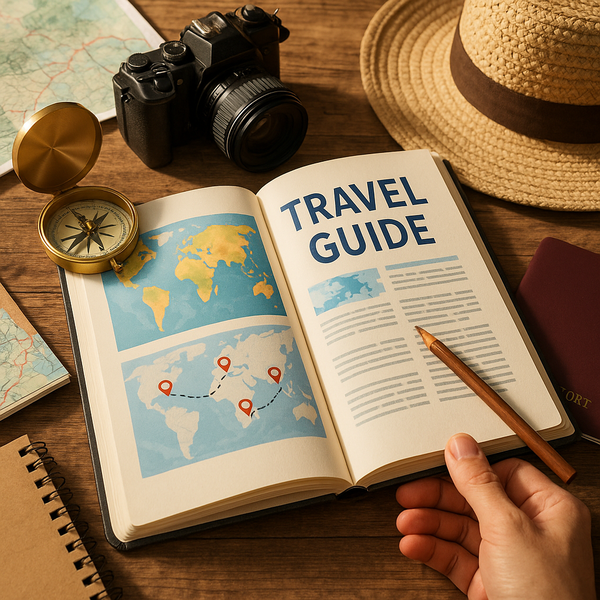
Embarking on a new journey can be thrilling, and having the right resources is key to a smooth and enriching experience. Comprehensive travel guides serve as your indispensable companions, offering insights, advice, and practical information to help you navigate unfamiliar places with confidence. They condense vast amounts of knowledge into an accessible format, transforming the daunting task of planning into an exciting part of the adventure itself.
What Defines a Comprehensive Travel Guide?
A truly comprehensive travel guide goes far beyond simply listing attractions. It provides a holistic view of a destination, equipping you with the knowledge needed from the moment you start planning until you return home. Key elements typically include in-depth information on history, culture, and local customs, ensuring you can engage respectfully and meaningfully with the place you're visiting. They offer practical advice on logistics such as visa requirements, currency exchange, and health precautions specific to the region.
Detailed sections on transportation are crucial. This covers everything from getting to the destination (flights, trains, buses) to navigating locally (public transit, taxis, car rentals). Comprehensive guides usually include information on airport transfers, train schedules, and tips for using local buses or subway systems. They might also provide advice on cycling, walking, or less conventional methods of getting around.
Accommodation options are another vital component. A good guide will cover a range of choices, from budget hostels and guesthouses to mid-range hotels and luxury resorts. They often include descriptions, typical price ranges (without promising 'best prices'), and advice on choosing the right type of lodging based on your budget and travel style. Some guides offer tips on booking in advance, especially during peak season.
Naturally, comprehensive guides highlight must-see attractions, but they also delve deeper. They might suggest off-the-beaten-path sights, provide background stories on historical landmarks, and offer practical tips for visiting popular spots, such as the best time to avoid crowds or whether booking tickets online is recommended. They often include curated walking tours or suggested itineraries.
Planning Your Trip Using a Guide
Using a comprehensive guide effectively starts well before you pack your bags. Begin by reading through the introduction and overview sections to get a general feel for the destination. Pay attention to sections on when to visit, typical weather patterns, and major festivals or events that might coincide with your trip.
Next, dive into the practicalities. Check the information on required travel documents, vaccinations, and travel insurance. Understanding the local currency and typical costs for food, transport, and activities will help you budget effectively. Look for safety tips specific to the region, including advice on common scams or areas to avoid.
Identify your interests. Are you a history buff, a food lover, an adventurer, or someone seeking relaxation? Use the guide's sections on attractions, activities, and dining to pinpoint experiences that align with your preferences. Comprehensive guides often categorize these based on interest or location, making it easier to plan.
Don't try to see everything. Use the guide to prioritize. Most guides offer suggested itineraries of varying lengths (e.g., 3 days in your city, one week in your country). These can serve as excellent starting points, which you can then customize based on your pace and interests. Map out your days, grouping nearby attractions together to minimize travel time.
Navigating and Experiencing the Destination
Once you arrive, your comprehensive guide becomes your street-level assistant. Use its maps (digital or print) to orient yourself. Pay attention to neighborhood descriptions, which can offer insights into local character, dining hotspots, and safety.
Dining information is a highlight of many guides. They often recommend restaurants covering different cuisines and price points, explain local dishes, and offer etiquette tips. Don't be afraid to try local eateries recommended in the guide – they often provide the most authentic experiences.
Comprehensive guides often include phrases in the local language, which can be incredibly helpful for basic communication, ordering food, or asking for directions. They also list emergency numbers and information on accessing medical facilities.
Look for sections on shopping, entertainment, and nightlife if those are your interests. Guides can point you towards local markets, theaters, music venues, or popular bars.
Remember that guides are tools, not rigid rulebooks. Be open to spontaneity and local recommendations you receive along the way. Sometimes the best experiences aren't listed in any book.
Choosing the Right Guide for You
With numerous publishers and formats available, selecting the right guide can seem daunting. Consider your destination and travel style. Some guides excel for backpacking and budget travel, while others focus on luxury or specific interests like hiking or food.
Look at the publication date. For practical information like opening hours, prices, and transport schedules, the more recent the guide, the better. However, historical and cultural information remains relevant regardless of age.
Consider the format: traditional print books are great for reading offline, highlighting, and easy flipping. Digital guides (e-books or apps) are convenient for carrying multiple guides, searching text, and often integrate with mapping services. Some guides offer audio or multimedia content.
Read reviews online to see what other travelers thought of the guide's accuracy, usefulness, and readability. Check if the guide includes detailed maps, which are often one of the most valuable features.
Beyond the Pages: Integrating Guides with Other Resources
While comprehensive guides are powerful tools, they work best when combined with other resources. Use online forums and blogs for up-to-the-minute information and peer recommendations. Apps like Google Maps, transit planners, and translation tools can complement the static information in a guide.
Official tourism websites often provide current event listings, information on temporary exhibitions, and booking platforms. Social media can offer visual inspiration and connect you with local perspectives.
Ultimately, a comprehensive travel guide empowers you to make informed decisions, feel more comfortable in unfamiliar surroundings, and enrich your understanding of the places you visit. They transform abstract destinations into navigable realities, ensuring your travels are not just trips, but truly memorable adventures.

